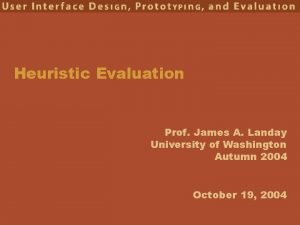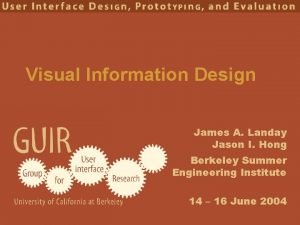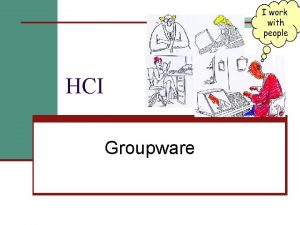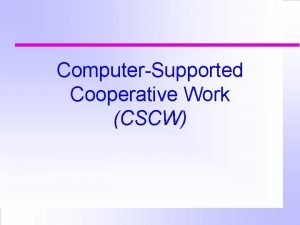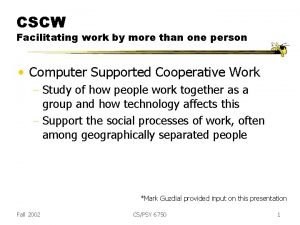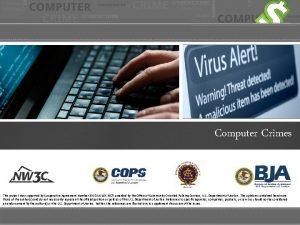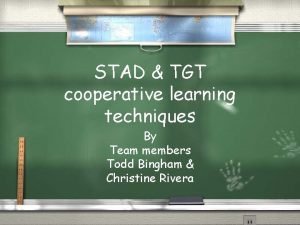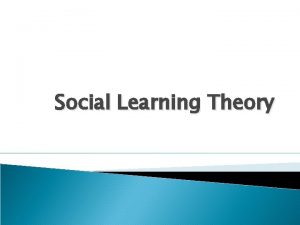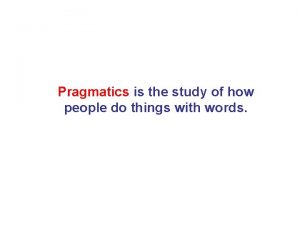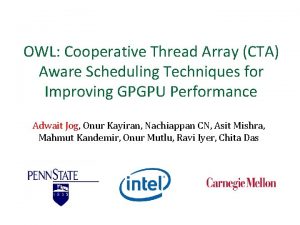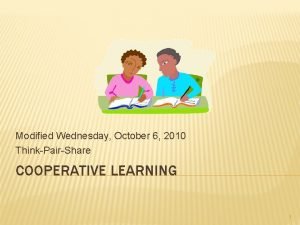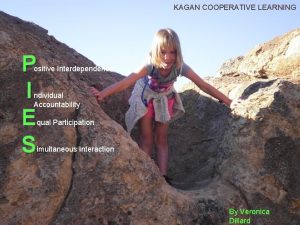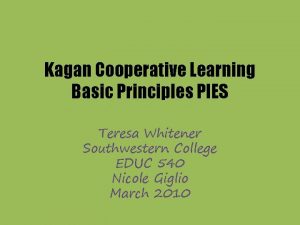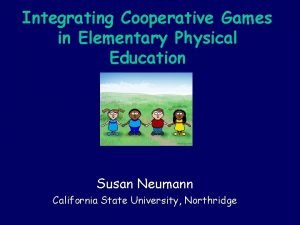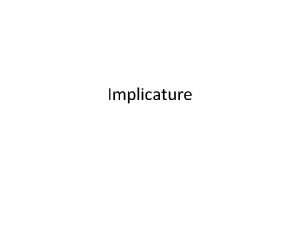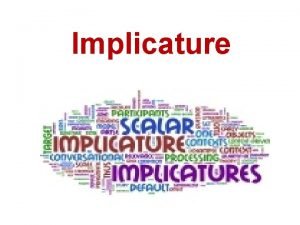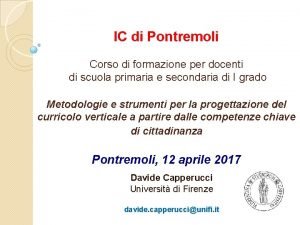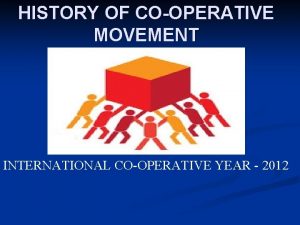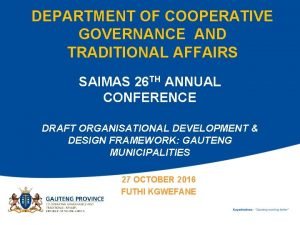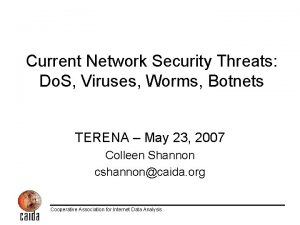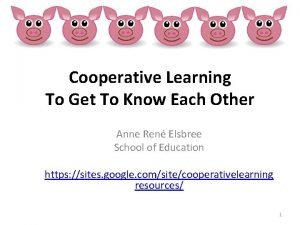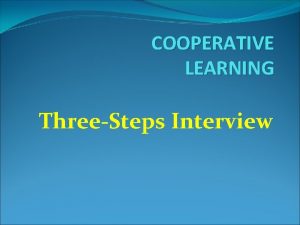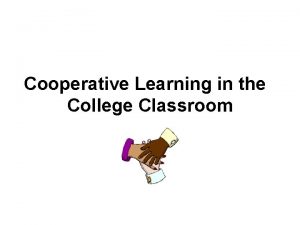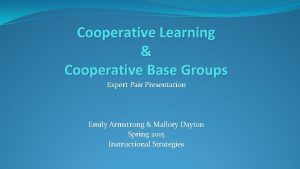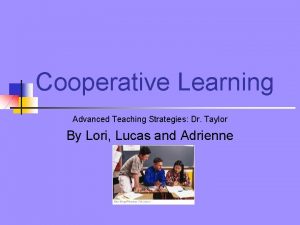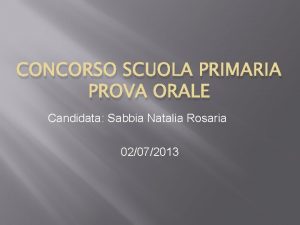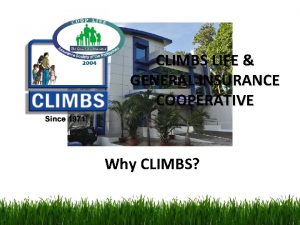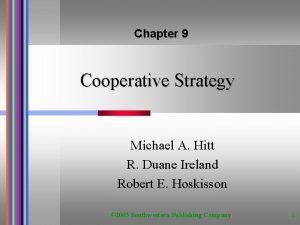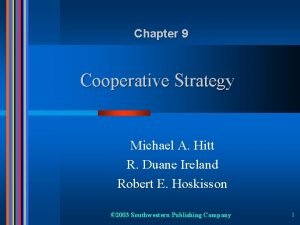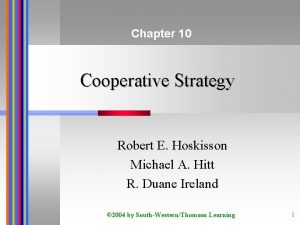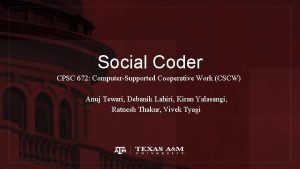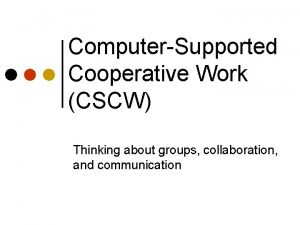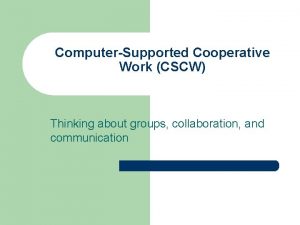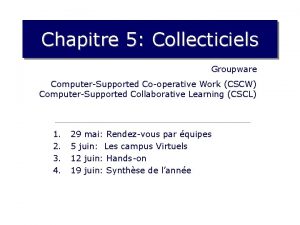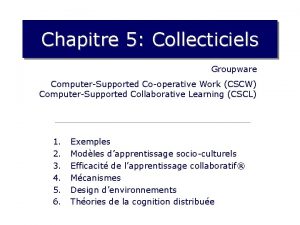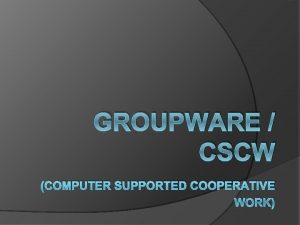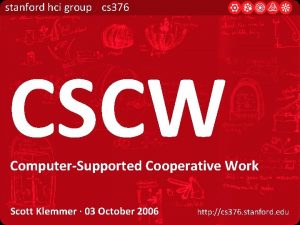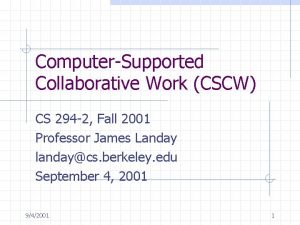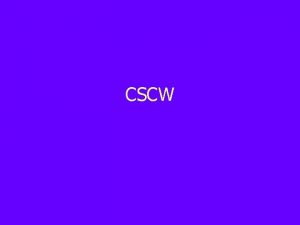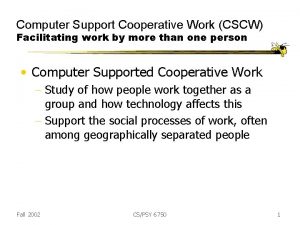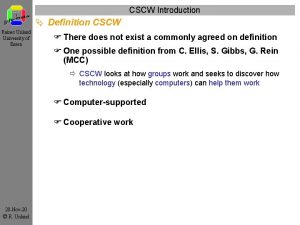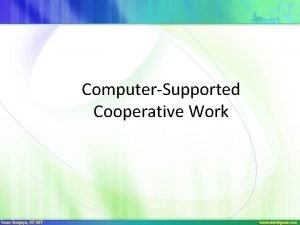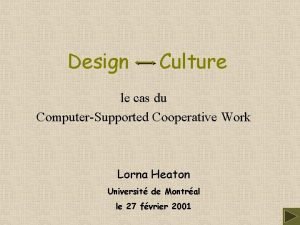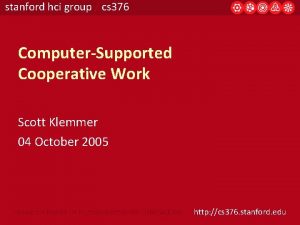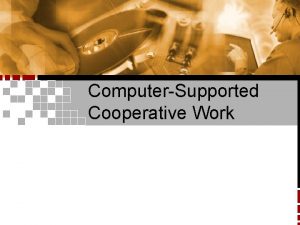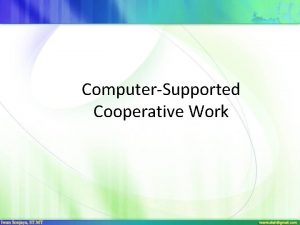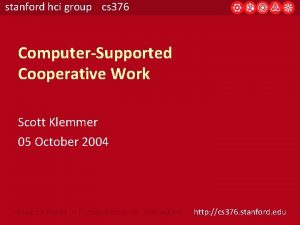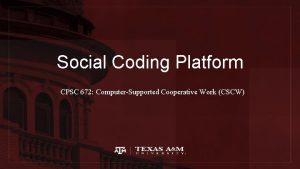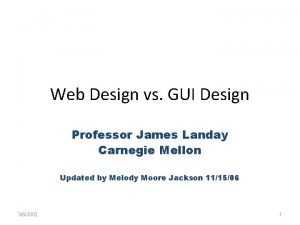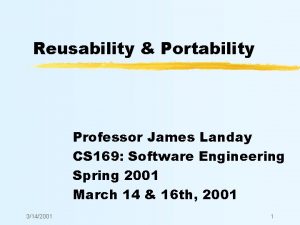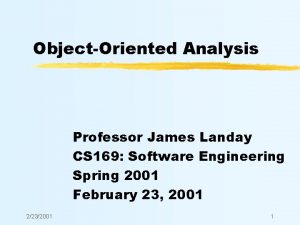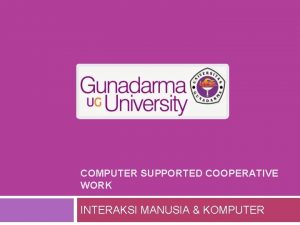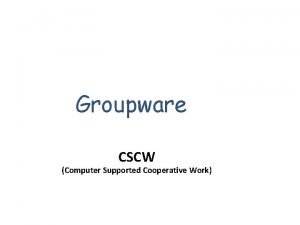ComputerSupported Cooperative Work CSCW Professor James Landay Spring










































- Slides: 42

Computer-Supported Cooperative Work (CSCW) Professor James Landay Spring 2002 April 1, 2002 * based on slides by Prof. Canny 4/1/2002 1

Hall of Fame or Shame? 4/1/2002 2

4/1/2002 3

4/1/2002 4

4/1/2002 5

4/1/2002 6

Hall of Shame z z z z Content not given enough screen real estate WARNING not that big of a deal (false alarm) Too many windows Poor layout Bad page titles Links don’t go where expected Doesn’t speak user’s language (doi? ) 4/1/2002 7

Computer-Supported Cooperative Work (CSCW) Professor James Landay Spring 2002 April 1, 2002 * based on slides by Prof. Canny 4/1/2002 8

Outline z z z Review of Rapid Prototyping Definitions of CSCW & group work Implementation issues Success/Failures Media 4/1/2002 9

Review of Rapid Prototyping z UI tools good for testing more developed UI ideas z Two styles of tools ? y “Prototyping” vs. UI builders y what is the difference? z Both types generally ignore the “insides” of application -> this is research 4/1/2002 10

Collaboration z Current work environments y several people working on personal workstations z Frequently people need to cooperate y create/modify documents, drawings, designs z Two key ways y at different times (asynchronously) x see changes previous workers have made y simultaneously (synchronously) 4/1/2002 x actions taken by user must be seen immediately 11

Computer-Supported Cooperative Work (CSCW) z Def. : “the study of how people work together using computer technology” z Examples of systems: y y y 4/1/2002 email shared databases/hypertext video conferencing chat systems real-time shared applications x collaborative writing, drawing, games 12

Groupware z Groupware denotes the technology that people use to work together y “systems that support groups of people engaged in a common task (or goal) and that provide an interface to a shared environment. ” z CSCW studies the use groupware y “CSCW is the study of the tools and techniques of groupware as well as their psychological, social, and organizational effects. ” 4/1/2002 13

Types of Cooperation z Focused partnerships y users who need each other to complete a task x often a document or image to work on x e. g. , joint authors of a paper z Lecture or demo y person shares info. with users at remote sites x questions may be asked x may wish to keep history and be able to replay 4/1/2002 14

Types of Cooperation (cont. ) z Conference y group participation distributed in space x at same time or spread out over time z Structured work process y a set of people w/ distinct roles solve task x e. g. , hiring committee accepts applications, reviews, invites top for interviews, chooses, informs y aka “work flow” or “task flow” 4/1/2002 15

Types of Cooperation (cont. ) z Meeting and decision support y meeting w/ each user working at a computer x e. g. , PDA Brainstorming tool z Tele-democracy y online town hall meetings 4/1/2002 16

Groupware Taxonomy Asynchronous Synchron Same place project scheduling, in/out board classro ATC Distributed e-mail, netnews, chat writing video conf. , netmeeting RCS, CAD, 4/1/2002 17

Key Issues z Group awareness z Multi-user interfaces y hard to design/conduct controlled experiments z Concurrency control y consistency and reconciliation z Communication & coordination y can’t see each other -> lose visual cues y floor control 4/1/2002 18

Key Issues (cont. ) z Latency y e. g. , user points at an object and talk z Security and privacy z more. . . 4/1/2002 19

Asynchronous Implementation Issues z Each user may have own copy of data z Must integrate changes at some point y example: programmers working on source z Problems when conflicts between changes y lock portions of work x keeps state well defined, although doesn’t stop semantically incompatible changes y resolve conflicts via integration mechanism 4/1/2002 20

Synchronous Implementation Issues z >=Two users working on same data, at the same time, in cooperation z Extend Model View Controller (MVC) y views & copies of the model are distributed z Propagate command history y must resolve conflicts among N histories y at what level are commands? x mouse position not good enough (e. g. , different font sizes, etc. ) 4/1/2002 21

Social Issues z Can these technologies replace human interaction? y can you send a “handshake” or a “hug” y how does intimacy survive? z Are too many social cues lost? y facial expressions and body language for enthusiasm, disinterest, anger y will new cues develop? e. g. , : ) 4/1/2002 22

Groupware Successes z Email y ubiquitous (your grandparents have it? ) z Newsgroups and mailing lists z Videoconferencing y growing slowly but steadily 4/1/2002 23

Groupware Successes (cont. ) z Lotus Notes y integrates email, newsgroups, call tracking, status, DB searching, document sharing, & scheduling y very successful in corporations y will the Web erode? Notes is more structured 4/1/2002 24

Groupware Failures z Shared calendars y making a come back? web-based? z Why does groupware fail? (Grudin) y y y 4/1/2002 disparity between workers & beneficiaries threats to existing power structures insufficient critical mass (Web reduces) violation of social taboos rigidity that counters common practice or exceptions 25

Success/Failure of Groupware z Depends on competing alternatives y collaborators down the hall or across country? z If users are committed to system, etiquette & conventions will evolve y tend to arise from cultural & task background y users from different orgs or cultural contexts may clash z Synchronous systems that work well for 2 users may be less effective w/ more users 4/1/2002 26

Administrivia z HE assignment now due on Wed. y questions? z My office hours moved to Tue. 2 -3 this week only 4/1/2002 27

Media z Video: Rich, but problems with gaze, gesture, non-verbal communication. z Audio: Conveys meaning well but not necessarily location z Text: Good for synchronous or asynchronous communication z Ink: Good for expressing ideas and brainstorming 4/1/2002 28

Video z Eye contact problems: y Offset from camera to screen y “Mona Lisa” effect z Gesture has similar problems: trying pointing at something 4/1/2002 29

Audio z Good for one-on-one communication z Bad for meetings. Spatial localization is normally lost. Can be put back but tricky. 4/1/2002 30

Turn-taking, back-channeling z In a face-to-face meeting, people do a lot of self-management z Preparing to speak: lean forward, clear throat, shuffle paper z Unfortunately, these are subtle gestures which don’t pass well through today’s technology z Network delays make things much worse 4/1/2002 31

Breakdowns z Misunderstandings, talking over each other, losing the thread of the meeting z People are good at recognizing these and recovering from them “repair” z Mediated communication often makes it harder z E. g. email often escalates simple misunderstandings into flaming sessions 4/1/2002 32

Usage issues z Communication in the real world has both structured & unplanned episodes y meeting by the Xerox machine z Much face-to-face communication is really side-by-side, w/ some artifact as focus 4/1/2002 33

Solutions z Sharing experiences is very important for mutual understanding in team work z Context-based displays (portholes) work well z Video shows rooms & hallways, not just people or seats 4/1/2002 34

Solutions z Props (mobile presences) address most of these issues. They even support exploration. 4/1/2002 35

Solutions z Ishii’s Clearboard: sketching + presence 4/1/2002 36

Face-to-Face: the ultimate? z It depends z Conveys the maximum amount of information, mere presence effects are strong. But… z People spend a lot of cognitive effort managing perceptions of each other z In a simple comparison of F 2 F, phone and email, most subjects felt most comfortable with the phone for routine business contact 4/1/2002 37

Face-to-Face: the ultimate? z Kiesler and Sproull found email-only programming teams were more productive than email+F 2 F teams in a CS course z There you want coordination, commitment, recording z Conclusion: Match the medium to the mission 4/1/2002 38

CSCL: Computer-Supported Collaborative Learning z Sub-area of CSCW concerned with learning & collaboration z Peer interaction is a powerful source of learning, especially in universities z Three powerful models: y TVI, DTVI: recorded instructor, team review y Peer instruction: pauses for group discussion y PBL: Problem-based learning, team problemsolving 4/1/2002 39

Livenotes z Designed to include other learners perspectives into note-taking 4/1/2002 40

Review z CSCW vs. groupware z Taxonomy based on space and time z Key issues y awareness, multi-user UIs, concurrency, communication & coordination, latency z Implementation and social issues y extend MVC y are social cues lost? z Successes (email) & failures (scheduling) 41 4/1/2002

Next Time z In class exercise z Bring two copies of your HE assignment 4/1/2002 42
 James a. landay
James a. landay James a. landay
James a. landay Shift work groupware
Shift work groupware Acceptance phase
Acceptance phase Cscw examples
Cscw examples Cscw
Cscw Language
Language Promotion from associate professor to professor
Promotion from associate professor to professor Spring, summer, fall, winter... and spring (2003)
Spring, summer, fall, winter... and spring (2003) Spring winter summer fall months
Spring winter summer fall months James russell odom and james clayton lawson
James russell odom and james clayton lawson James russell odom and james clayton lawson
James russell odom and james clayton lawson Work spring formula
Work spring formula Ohio valley educational cooperative
Ohio valley educational cooperative Cooperative model example
Cooperative model example Cooperative vs collaborative learning
Cooperative vs collaborative learning Tgt cooperative learning
Tgt cooperative learning Social context definition
Social context definition Cooperative governance
Cooperative governance Pedagogia non direttiva rogers
Pedagogia non direttiva rogers Flouting maxims examples
Flouting maxims examples Cooperative thread array
Cooperative thread array Think pair share cooperative learning
Think pair share cooperative learning Features of industrial estate
Features of industrial estate Pies kagan
Pies kagan Pies principles
Pies principles Cooperative games for elementary students
Cooperative games for elementary students What is conventional implicature
What is conventional implicature Particularized conversational implicature examples
Particularized conversational implicature examples Compito di realtà organizzare un viaggio scuola primaria
Compito di realtà organizzare un viaggio scuola primaria History of cooperative movement in india
History of cooperative movement in india Cooperative governance
Cooperative governance Cooperative association
Cooperative association Pigs face cooperative learning
Pigs face cooperative learning Three steps interview
Three steps interview Examples of cooperative learning
Examples of cooperative learning Cooperative base groups
Cooperative base groups Types of cooperatives
Types of cooperatives Griglia di osservazione cooperative learning
Griglia di osservazione cooperative learning Climbs life and general insurance cooperative
Climbs life and general insurance cooperative Corporate level cooperative strategy
Corporate level cooperative strategy Corporate level cooperative strategy
Corporate level cooperative strategy Corporate level cooperative strategy
Corporate level cooperative strategy
